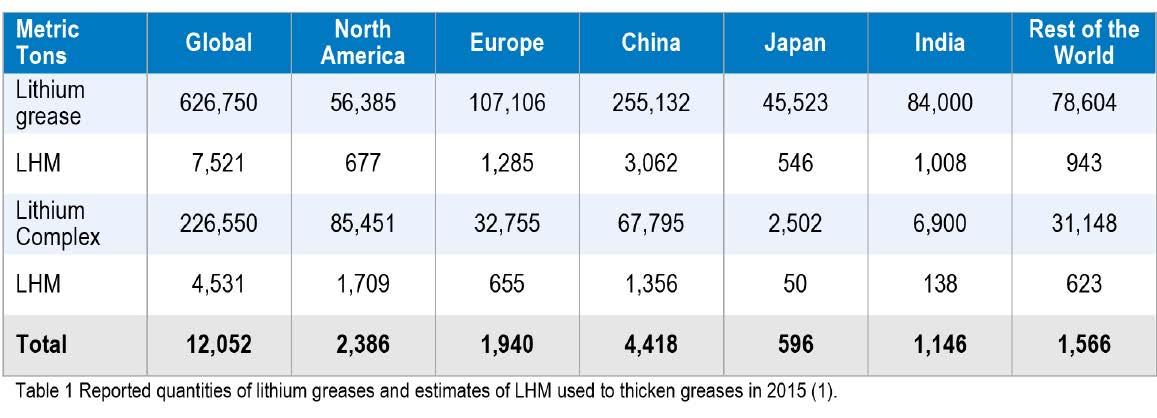
30 minute read
Lubricating Grease Thickeners: How to Navigate your Way through the Lithium Crisis
Abstract
The most important difference between a lubricating grease and a liquid lubricant is the thickener that gives the grease its structure. The thickener is responsible for the non-Newtonian behavior and some characteristics of the lubricating grease. Since Clarence E. Earle first filed for a US patent in 1940 for the use of lithium soaps as lubricating grease thickeners, their use has grown to 75% of the global market.
Grease makers are looking to replace, supplement or change the lithium and lithium complex thickener systems of greases that they manufacture with alternative thickeners due to critical changes in cost and availability of lithium. This paper will review the 2015 NLGI grease production survey, discuss thickener options, and highlight experimental results for three thickener systems that deliver the same performance as lithium. These three thickener options are borate ester technology, anhydrous lithium hydroxide dispersions, and high soap calcium sulfonate complexes.
Introduction
The largest volume of grease thickeners sold globally are lithium soaps with around 54.5% based on conventional soaps and lithium complexes at almost 20% of the global market in 2015 (1). Comparing these volumes to the 2005 figures (2), it is apparent that the volume of simple lithium soap has fallen from 57.6% to 54.5%, but the volume of lithium complex thickeners has almost doubled from 10.8% to 19.7%.
This is a significant simplification of the actual regional volumes, and to understand the need for alternative thickener technology these volumes need to be looked at regionally.
• In North America, lithium complex thickeners are the dominant player with 39.1% of the market followed by conventional lithium soaps (25.8%) and aluminum complexes being a distant third (8.8%). All calcium soaps grouped together make up only 4.5% of the market • In Europe, conventional lithium soaps make up 53.3% of the market, lithium complex thickeners 16.3%, and no other thickener more than 6%. Collectively though, calcium soap greases make up just over 10% of the market.
• The other significant regional differences are Japan and the Indian Sub-continent. In Japan, 56.4% of thickeners is conventional lithium soap, but only 3.1% s lithium complex.
The other commonly used thickener volumes are polyurea and urea complex with 28% of the market. Calcium soaps and other specialty thickeners account for around 5% each.
By contrast, in India, conventional lithium soaps dominate the market approaching 85% with complexes only around 7%. The Chinese market consists of 63.6% conventional lithium and 16.9% lithium complex thickeners. The rest of the world uses approximately 150,000 metric tons (12.3% of the global grease volume); about 53% is conventional lithium and 20% lithium complex.
A conventional lithium grease thickened with only 12-hydroxystearic acid uses about 1.2 wt% of lithium hydroxide monohydrate (LHM), and a diacid carboxylate complex grease uses about 2.0 wt% LHM.
Reviewing grease volumes, it is clear that the growing volume is lithium complex with conventional lithium embracing the commodity market. There is a perceived need to improve the properties of lithium complex greases in the following areas: water resistance; oxidation stability, grease life; and bleed. Oxidation stability and life improvements have been presented previously (3), and polymer technologies are available to improve water resistance (4).
In North America, new specifications have appeared that require dropping points above 280 °C. Some customers have requested thickener systems that have consistently high dropping points above 300 °C, trying to match the behavior of calcium sulfonate greases. However, the majority of lithium complex greases sold in North America have dropping points
Lubricating Grease Thickeners:
How to Navigate your Way through the Lithium Crisis
By: Gareth Fish, PhD CLS CLGS, Chris Hsu, PhD, and Robert Dura, PhD The Lubrizol Corporation
of 260 °C to 280 °C. Historically in Europe, higher temperature greases had to possess dropping points only above 220 °C. With the globalization of specifications, dropping points for high temperature greases above 260 °C are now required by the majority of published specifications.
In the last 10 years, lithium ion batteries have risen to be the energy storage media of choice. The battery in a cell phone uses up to 6 grams of lithium, whilst a laptop computer or tablet uses 20 to 40 grams of lithium (5). The biggest new drivers of lithium demand are plug-in electric vehicles. It is estimated that a 70 kWh battery to power a plug-in electric bus or performance car would use 63,000 grams of lithium, the equivalent to 10,000 cell phones. From Table 1, the amount of lithium metal used in grease in 2015 was around 2,000 metric tons. The volume of lithium metal sold into batteries in 2015 was 12,000 metric tons. This volume is predicted to increase to 24,800 metric tons in 2020 and to 48,700 metric tons in 2025. This volume for batteries is larger than the projected supply volume available (5).
This demand for lithium for batteries has created a shortage of supply and a significant increase in prices of LHM. In 2016, the price of LHM doubled in North America, tripled in most of the rest of the world, and in India rose more than seven times the average 2015 price. For a conventional lithium grease in North America, the cost of LHM increases the cost of the base grease by about 13% and by about 19%.for a carboxylate lithium complex base grease.
Grease makers are now looking to replace, supplement or change the lithium and lithium complex thickener systems of greases that they manufacture with alternative thickeners. Reviewing the available options for grease makers it is clear that the usable alternative thickeners depend on significant regional market forces and manufactured volumes. This paper will now discuss thickener options and highlight a few ways that grease makers can deliver the same performance with modified and alternative thickener systems.
Industrial and Automotive Grease Options
In North America, lithium complex is the dominant thickener with conventional lithium soaps being mostly used for commodity greases. A significant portion of the lithium complex greases is used in automotive applications. Today, very little calcium sulfonate, aluminum complex or calcium sulfonate complexes are sold into the automotive industry. Based on past experiences, it is not likely that the volumes of these three thickener types will increase much for automotive applications.
It should be possible for North American automotive component manufacturers to migrate to urea thickened greases like those used in the Japanese automotive industry. In Japan, there appears to be available capacity to manufacture urea greases, and it is likely that the migration to urea greases from lithium will further accelerate in Japan. For industrial applications, lithium complex greases, can be replaced by calcium sulfonate, aluminum complex or calcium sulfonate complexes and in some instances, where compatibility is not an issue, by clay thickened greases.
Electric motors are another area where both lithium complex and urea thickeners are used. Prior to the recent steep rise in lithium prices, lithium complex greases were a lower cost option for electric motors compare to the higher priced ureathickened greases. The gap in costs has narrowed, and lithium complex grease prices may rise above those for urea greases if the LHM price rises much further.
In Europe, the outlook appears to be much bleaker. Chemical regulation of di-isocyanates and urea thickeners seems to preclude switching to urea greases. Again, the European automotive industry has little experience using calcium sulfonate and aluminum complex greases. For industrial greases, these two thickeners would offer alternatives, as would using anhydrous calcium, clay, or calcium complex thickeners, which are still made in quantity. However, calcium greases do not match the temperature profile of lithium greases, and it would be necessary to improve the thermal stability of calcium
In India, grease makers face similar challenges to their colleagues in Europe. They have been looking to replace lithium greases with mixed calcium-lithium soap (6) for automotive applications, but face the thermal stability issue of calcium and mixed soap greases. Titanium complex greases have been proposed for steel mills and other industrial uses (7). Work has just started in India to look at urea greases (8) for use as alternatives to lithium complex greases.
The use of boron additives in lithium greases
Boric acid has been used for a number of years as an alternative to aromatic acids or dicarboxylic acid complexing agents for lithium greases. As described in the NLGI Grease Guide 6th Edition (9), boric acid can be difficult to incorporate and is currently the subject of regulatory scrutiny. Other sources of boron that can be more easily incorporated into the greases are now preferred. Borate esters are a relatively easy way to deliver higher dropping points. Traditionally, low molecular weight borate esters were used, but other components to do this are now available. Lorimor (10) described and reviewed various boron chemistries that are available, noting that some work better when used in conjunction with a zinc dithiophosphate (ZnDTP) additive. Table 2 compares data for several combinations of borate and ZnDTP additives in a lithium base grease.
Based on the data presented in Table 2, borate esters can deliver elevated dropping points. However, borate esters are not without issue. Hydrolytic and thermal stability can be poor and they can release alcohols and boric acid, which is an environmental concern in some markets. The alcohols can give rise to odors, which may be undesirable. The earliest borate esters used butanol or isobutanol. Because of the issues related to hydrolytic and to thermal stability, along with the pungent odors, additive manufacturers switched to longer chain alcohols for the products sold today.
A new lower odor borate ester was developed and tested in a variety of greases to investigate its effect on the dropping points and to explore its use as a grease complexing agent. The first study used a conventional lithium grease base with an ISO VG 100 Group I mineral oil and compared two borate esters, with and without ZnDTP. The current borate ester was BE1, and the new, lower odor borate ester was BE2. The base greases were heated to 100 °C and the borate esters were mixed in, followed by the ZnDTP. Then, the greases were milled and de-aerated. As can be seen from the data in Table 3, the new odorless borate ester (BE2) additive matched the behavior of the current borate ester (BE1). All greases treated with the borate esters had dropping points above 260 °C.
Grease complexing agent issues
The demand for lithium complex grease has increased globally by 30% over the last few years, from 15% of the market in 2005 to just under 20% in 2015. Typical dicarboxylate lithium complex greases use around 2.0% lithium hydroxide compared to around 1.2% for a simple lithium grease or a borated lithium complex.
According to the NLGI Grease Guide (9), a complex soap thickener contains a thickening soap and a complexing agent. The thickening soap solidifies the base oil, and the complexing agent gives the thickening soap better thermal stability. The Guide further states that the choice of complexing agent depends on the metal in the thickening soap. Calcium soaps are typically complexed with acetic acid, and aluminum soaps are complexed with benzoic acid. The first complexing agent used for lithium soaps was acetic acid (9), but this did not give the grease the same stability as it did for calcium greases. In the 1970s, boric acid was first used as a complexing agent. Other aromatic organic acids such as salicylic or
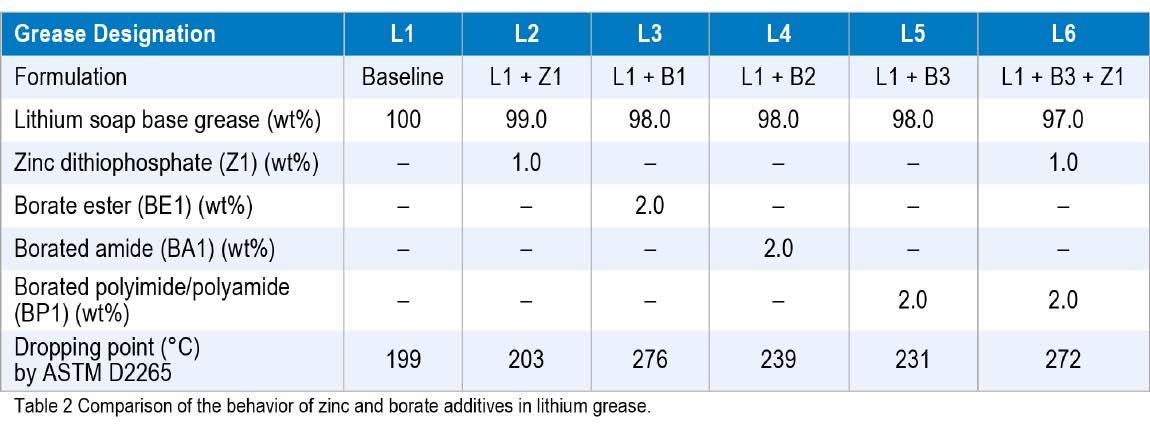

p-hydroxybenzoic acid were also first used about this time, but today only a small number of manufacturers still use this technology. Dicarboxylic acids became the complexing agents of choice and dropping points above 260 °C could be readily obtained. At the current time, azelaic (C9) and sebacic (C10) acids are used most commonly, and adipic (C6) and dodecanedioic (C12) are used to a lesser extent. As reported in 2014 (11), it can be challenging to control the grease making process to get good complexing with these acids. Today there appears to be a supply shortage of sebacic acid, which is further restricting the growth of lithium complex greases.
In their 2014 NLGI paper, Fish and Hsu (12) outlined how the use of a micronized and dehydrated lithium hydroxide dispersion in oil could help to make superior carboxylate lithium complex greases with higher dropping points and better thermal stability. With today’s issues related to the cost and supply instability of LHM, that work was revisited and looked at not from a view point of making the grease better, but to match the performance at lower lithium and complexing acid content.
Four greases (358, 365, 366 and 375) were compared. Greases 358 and 375 used the same amount of 12-hydroxystearic and azelaic acids (73.8 and 22.9 g, respectively), as did Greases 365 and 366 (86.3 and 10.7 g, respectively) but different amounts of lithium hydroxide additives and base oil, Table 4. The amount of oil for the lithium dispersion greases was reduced to keep the thickener content constant and was targeted at 10 wt% thickener.
It was reported that the lithium hydroxide dispersion not only reacted faster and reduced the time to process a batch, but also gave slightly better grease yields (12). However, comparing the raw material costs of greases 358 and 375, the one using the lithium hydroxide dispersion (358) on an equal cost basis attracts about a 3% premium over the cost of the one manufactured with LHM in water (375). Comparing the penetrations and dropping point of Grease 375 with Grease 365, these basic properties are the same (within test method repeatability).
Comparing the raw material costs for greases 365 and 375), the one using the lithium hydroxide dispersion with the lower content of diacid (grease 365), offers a cost reduction of 5.5% compared to the cost of the grease made with standard LHM powder mixed with water route (grease 375),. The additional thing to note from the previous paper is that it takes about 4 hours less to run a 1 step process with a single co-saponification reaction compared to running a two-step sequential saponification. The data for the four carboxylate complexes is included in Table 4. Not only does the use of the lithium hydroxide dispersion use less diacid, but also saves considerably on the amount of lithium equivalents needed for each batch of grease.
Borate esters as complexing agents
As reported earlier, boric acid is a well-known complexing agent for lithium greases but is not without issues. The key question that has arisen about the use of borate esters in grease is whether they can replace both boric acid and dicarboxylic acids as complexing agents.
To address this question, three greases were prepared. The base oil was a mixture of 112 mm2/s (112 cSt at 40 °C) Group I paraffinic oil and 2000 Dalton (g/mol) polyisobutylene (PIB), giving an ISO VG 220 final base oil viscosity. All three greases used the same multi-purpose zinc-containing additive package at 4% treat rate. This additive package was used in order to
Notes: Penetration is defined as the distance a cone of specified dimensions, mass and surface finish falls into the grease when allowed to drop for 5 seconds. The penetration is measured in tenths of a millimeter, typically written as dmm (9). Thickener concentration calculation is given in the Appendix.
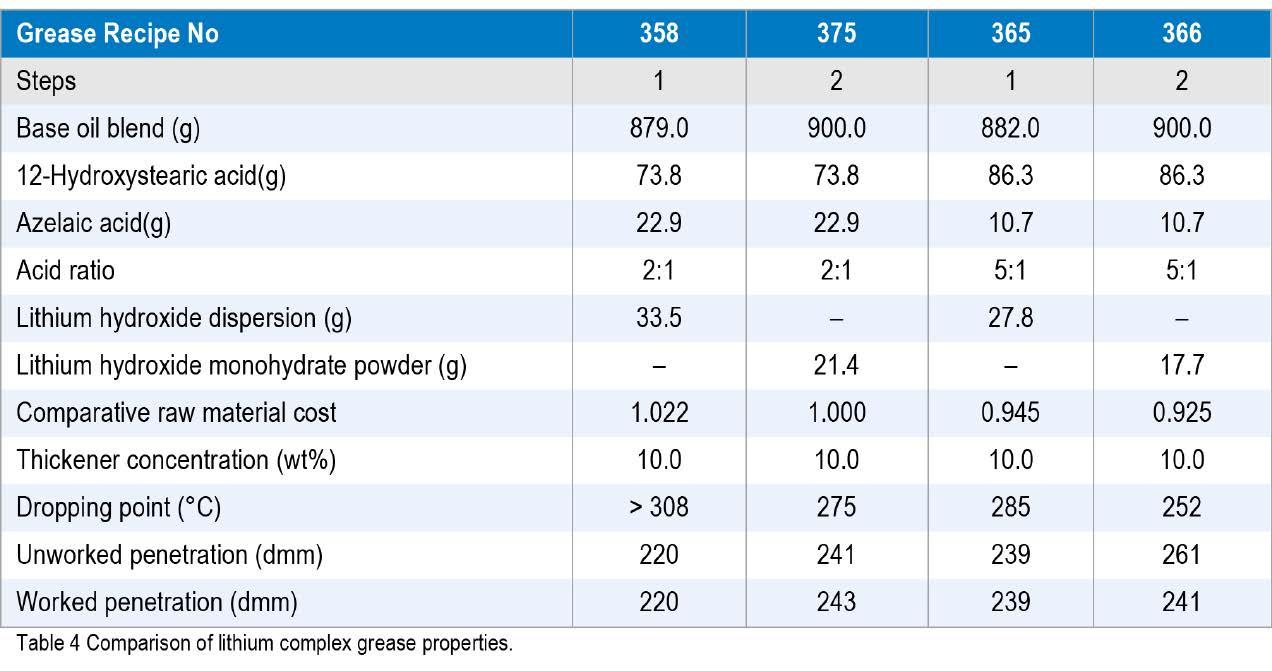
The first sample, Grease 89, was a 2:1 acid mole ratio sebacate complex with a thickener content of 10.7 wt%. The second, Grease 90, was a conventional lithium soap grease with 5.5 wt% 12-hydroxystearate soap, and the third, Grease 91, had 5.7 wt% lithium 12-hydroxystearate soap complexed with 2 wt% of the low odor borate ester, BE2.
Standard tests were carried out to compare the performance of these three greases and the results are reported in Table 5.
The data gathered so far show that a borate ester lithium complex grease performs as well as a dicarboxylate lithium complex and better than a conventional lithium soap grease. The increase in oxidation life for the borate grease, measured by the increase in oxidation induction time (OIT) using pressure differential scanning calorimetry (PDSC), confirmed results reported by Lorimor (10). Also revisited were the rheological behaviour and a reciprocating temperature ramp test used by Lorimor (10). In this rheology test, the lithium soap grease started to soften above 180 °C, but the two complex greases were fairly stable to 260 °C. The behaviour of the three greases is shown in Figure 1.
By switching from a diacid to a borate ester for the complexing agent, grease makers can save on the raw material costs for making a lithium complex grease. Looking at just raw material costs for conventional lithium and borate esterlithium complexes, based on the current price of LHM ($25 / kg) it still just cost effective to use it as the lithium source. Moving to the borate ester complex would use significantly less LHM and, in the case of supply shortage, allow the grease maker to produce 2.7 times the amount of borate ester-lithium complex grease compared to a dicarboxylate complex. Comparison of the costs of the grease and the amounts of LMH and lithium metal are included in Table 6.
The use of borate ester additives in calcium greases
The next option studied to reduce the reliance on lithium hydroxide was to investigate if anhydrous calcium greases could be used instead of lithium soap greases. In North America, anhydrous calcium greases account for about 3.8% of the market, which equates to 8,300 metric tons. In China, 14,000 metric tons of anhydrous calcium soap greases are sold (3.5% of the market), and in Europe, the volumes are 3.2% of the market or 6.500 metric tons.
If the ISO 2176 or IP 396 test methods are used to measure the dropping point of anhydrous calcium greases, a typical value of around 145 °C is obtained.
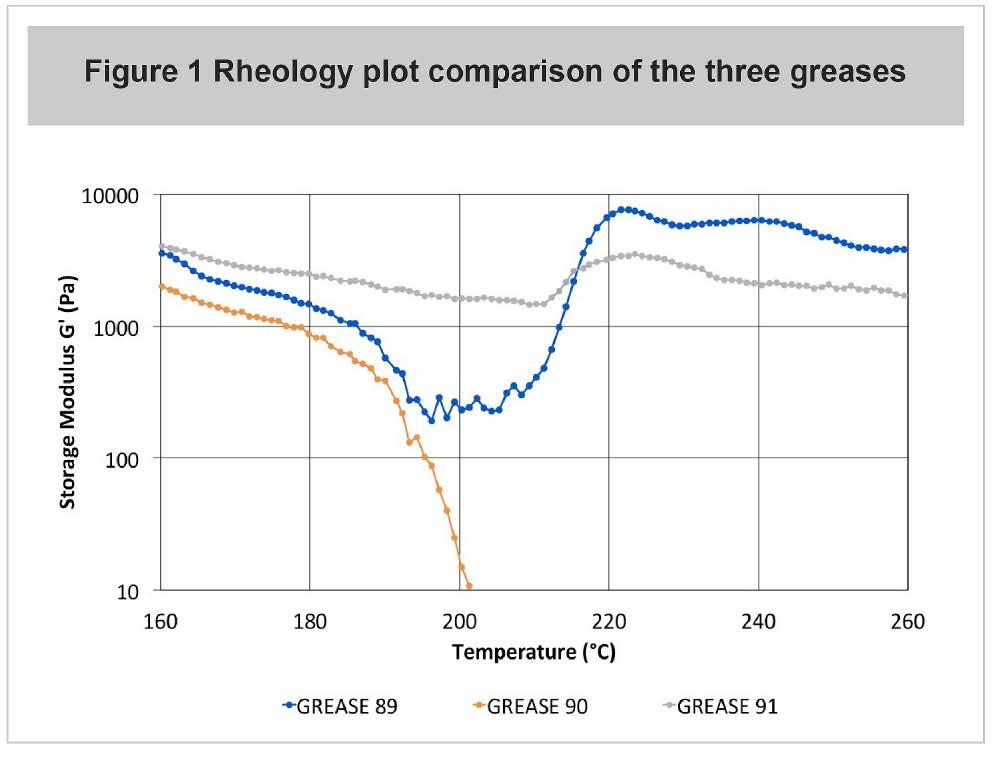
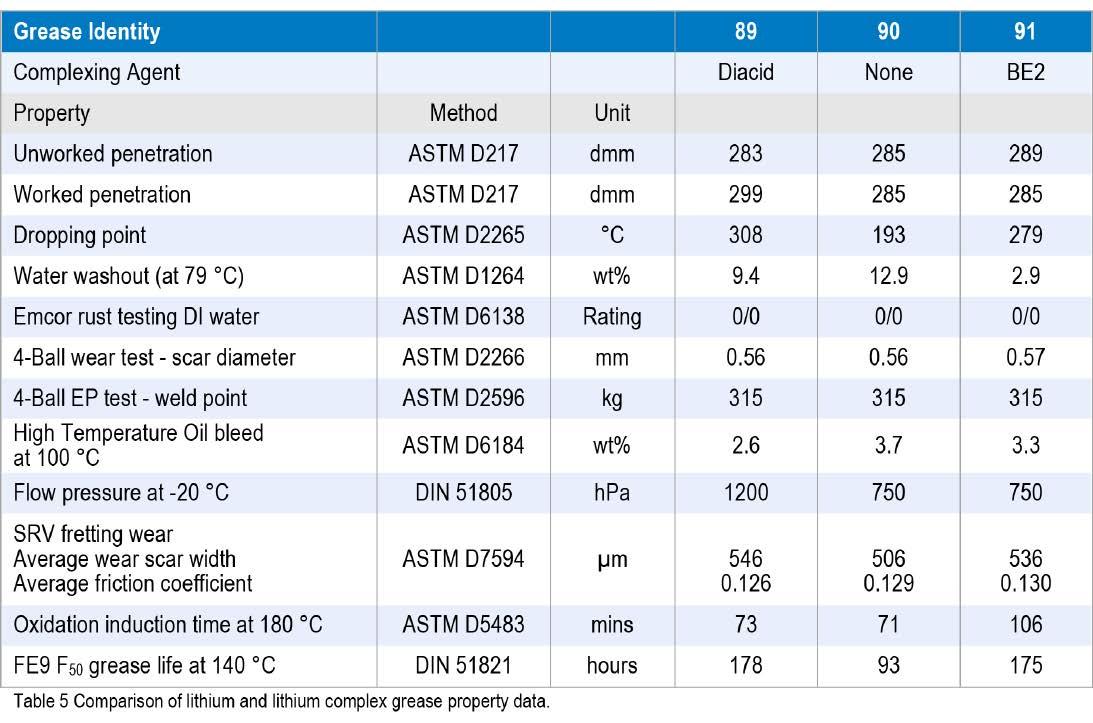


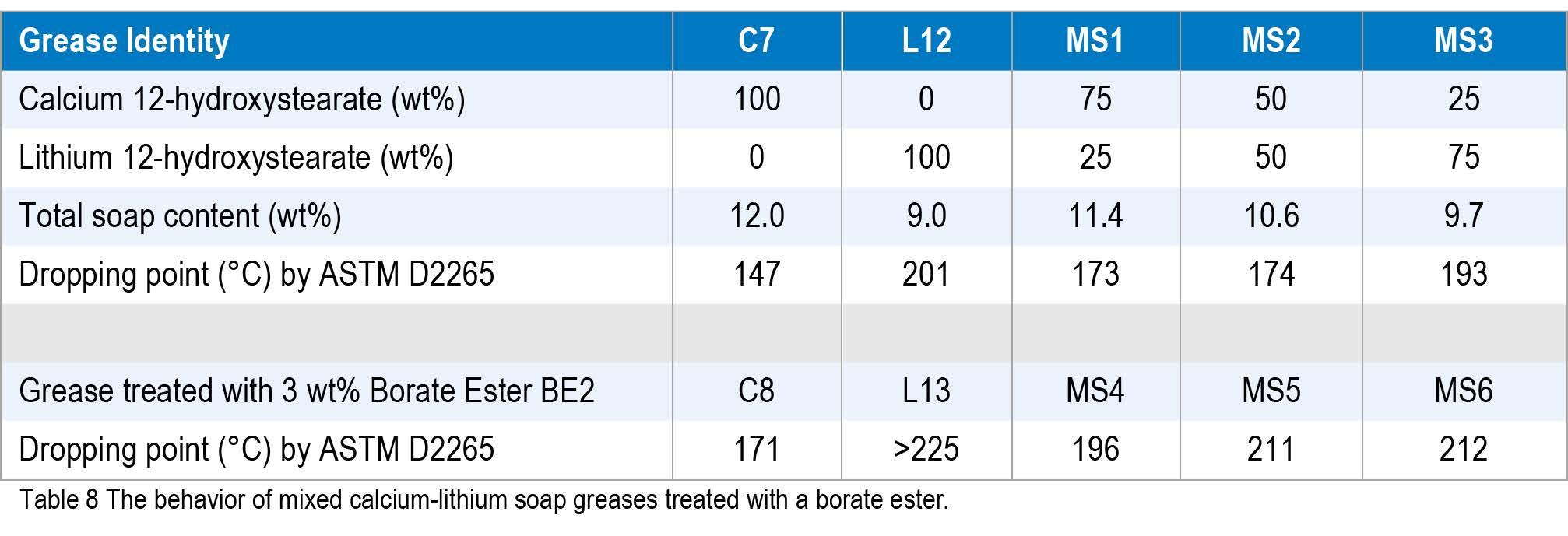
When using the ASTM D2265 method, dropping point values of around 155 °C are obtained. This latter test method is not used widely in Europe. Several specifications demand a dropping point above either 163 °C or above 177 °C, which cannot be met easily by anhydrous calcium greases, and hence, conventional lithium soap greases are used.
The present study investigated whether borate ester chemistry could boost the dropping point of such anhydrous calcium greases, with and without ZnDTP, to above the 163 °C minimum requirement. An NLGI #2 anhydrous calcium soap grease was prepared using an in situ reaction of hydrated lime mixed with water and 12-hydroxystearic acid in a 30:70 blend of a 750 naphthenic oil with a Group II 600N paraffinic oil. Table 7 shows the data from the study of borates on the dropping point of anhydrous calcium greases.
The results of this study showed that it was possible to use borate esters to achieve dropping points above 163 °C but not above the 177 °C minimum. This suggests that borate esters could be used to boost the dropping point to meet some lower lithium soap specifications but not applications that required dropping points above 177 °C.
Next, this study investigated the use of borate esters to increase the temperature resistance of mixed soap calciumlithium greases and check whether they could exceed the 177 °C limit. Initially, an anhydrous calcium grease (C6) and a conventional lithium grease (L11) were manufactured using the same naphthenic-paraffinic base oil blend from above. Dropping points were measured after these greases were manufactured and again after treating with 3 wt% of the borate ester BE2 as above. Samples of the two base greases (C6 and L11) were then combined in ratios of 75:25, 50:50 and 25:75. The samples were milled and deaerated and tested for dropping point, and then treated with 3 wt% of the borate ester BE2 and tested. The dropping point results in Table 7 for the simple mixtures did not reach the target of 177 °C without mixing more than 50 wt% of the lithium soap base mixed with the anhydrous calcium base.
However, mixing a finished lithium 12-hydroxystrearate grease and with an anhydrous calcium grease is not a practical reality. Three new greases were manufactured in the same base oil blend as before. The 12-hydroxystearic acid was heated in the oil, and then the lime and lithium hydroxide monohydrate (mixed together with water) were added to the oil. The mixture was held at 90 °C or one hour for saponification and then heated to 200 °C followed by cooling to 100 °C. Each sample was then divided in two equal portions, and borate ester BE2 was added to one portion. The greases were milled and deaerated, and dropping points were measured by ASTM D2265, Table 9.
It is clear from the dropping point data in Table 9 that adding 3 wt% of the BE2 to the 75 wt% calcium: 25 wt% lithium mixed soap grease (Grease MS10) gave a similar dropping point (187 °C) to that of the 25 wt% calcium: 75 wt% lithium (Grease MS9) without the borate ester (189 °C). Both MS9 and MS10 had higher dropping points than the177 °C target. With the borate ester, it was possible to use a lower amount of lithium grease to meet this dropping point specification.
The next step was to look at the relative costs of using additional lithium hydroxide versus adding the borate ester. Raw material costs were calculated from typical market prices for hydrated lime, LHM, 12-hydroxystearic acid, and the two base oils. Relative costs for the various options could be compared on a raw material basis, normalized to the cost of one kilogram of the anhydrous calcium soap thickened grease, C6. The relative costs in Table 10 illustrate that at June 2017 prices of LHM, there is almost no cost difference between MS9 and MS10 greases. The biggest difference is that MS10 uses one third of the amount of LHM compared to MS9. If the price of LHM rises (and/or its availability becomes limited), a formulation such as MS10 becomes more attractive.
Calcium Sulfonate Greases
Sulfonate greases have found widespread use in applications that require high temperature tolerance and good load carrying capacity. The general process for making gelled calcium sulfonate grease has remained largely unchanged since these types of greases were first developed in the 1960s (13). Firstly, an overbased calcium sulfonate with a total base number (TBN) of 300 to 500 mg KOH / g equivalents is added to a grease kettle. The highly overbased sulfonate is mixed with base oil and treated with acid to destabilize the micellular structure. Then, promoters and water are added, and the material is heated to its gelation temperature. Provided that the water and promoters are retained in the mixture, the amorphous calcium carbonate is converted to crystalline calcite within one to five hours. The final step is the removal of water and promoters from the mixture.
Prior to 1985, calcium sulfonate greases based on natural sulfonates (a by-product of Group I refining in which the distillate fraction is treated with oleum to remove aromatics) were a niche product manufactured and sold only in small quantities. The greases had very good antiwear and extreme pressure (EP) properties without the use of additives along


with dropping points above 300 °C and low oil separation. Their negative aspects were high thickener content and associated cost compared to other greases, and water spray off and low temperature mobility.
At the NLGI Annual Meeting in 2008, Denis and Sivik (14) presented a paper on improvements to calcium sulfonate gelling technology. They outlined a procedure to incorporate the promoter system into an overbased synthetic sulfonate so that only base oil and water were needed for gelation. This procedure avoided issues associated with ‘flash’ of isopropanol and other alcohols used in gelation. Their work opened up the potential for sulfonate grease technology to a wider number of grease makers. However, this process did not produce grease faster than other sulfonates.
One further challenge with calcium sulfonate technology is the promoter, an azeotrope mixture of alcohol / glycol, and water. If gelation is not carried out in a closed reactor, promoter and water are lost, and the gelation reaction stalls. At 90 °C, this loss of promoter and water takes between 60 minutes and 90 minutes. Carrying out the gelation at a colder temperature (80 °C) slowed down both the calcite conversion and the loss of promoter, no improvement in process time, and no prevention of stalling.
In the present study, two possible avenues were explored to try to make the gelation process faster and more user friendly. The first avenue explored was to change the alcohol/glycol promoter. In earlier work (14), isopropanol worked well as did hexylene glycol. Propylene glycol, which is approved as a promoter for food grade greases, did not work when used at equivalent hydroxy content and equivalent weight. Other promoters, including 2-methoxyethanol and mixtures of alcohols and glycols, did not improve the processing time to gel the grease faster than the original alcohol/glycol promoter.
The second area of investigation was to change the acid. The current process uses an alkenyl-substituted carboxylic acid, a fairly weak organic acid. Succinic and sulfonic acids are used according to some of the published literature. (13), (14), and (15). Mixtures of succinic acid with alkyl-substitutions were tried as well. Short chain succinic acids generally produced firmer gels with higher yields than long chain succinic acids, but the amount of time to gel was the same. Unsubstituted succinic acid had to be melted and dissolved into the oil prior to reaction, which made it more difficult to handle them than the substituted succinic acids, which were viscous liquids at room temperature. Succinic anhydride was also tried, but it was necessary to hydrate it before use.
The logarithmic acidity constant (pKa) of acetic (4.8), succinic (4.3), and alkyl-substituted succinic acids (5.6) identifies them as weak acids. These weak acids react more slowly with weak bases than stronger acids with a pKa < -2. Sulfonic acids can have pKa values down to -2.8, and the reaction with the lime can proceed very quickly in some cases. This results in a faster destabilization of the micellular structure of the sulfonate and faster conversion.
Therefore, a commonly used alkylbenzene sulfonic acid was chosen to replace the alkylsuccinic acid. A series of sulfonate blends was prepared with different ratios of the acids to sulfonates and to the glycol/alcohol. Speed of gelling, ease of use, and basic properties of the gels were investigated. A particular acid ratio was chosen for scale up because it produced much faster gelling than the previously reported 3 hours (14). A batch of grease made with 63% of the new sulfonate blend and 37% of BS150 oil was made in under two hours from start to finish. The basic properties of this grease are in Table 11.
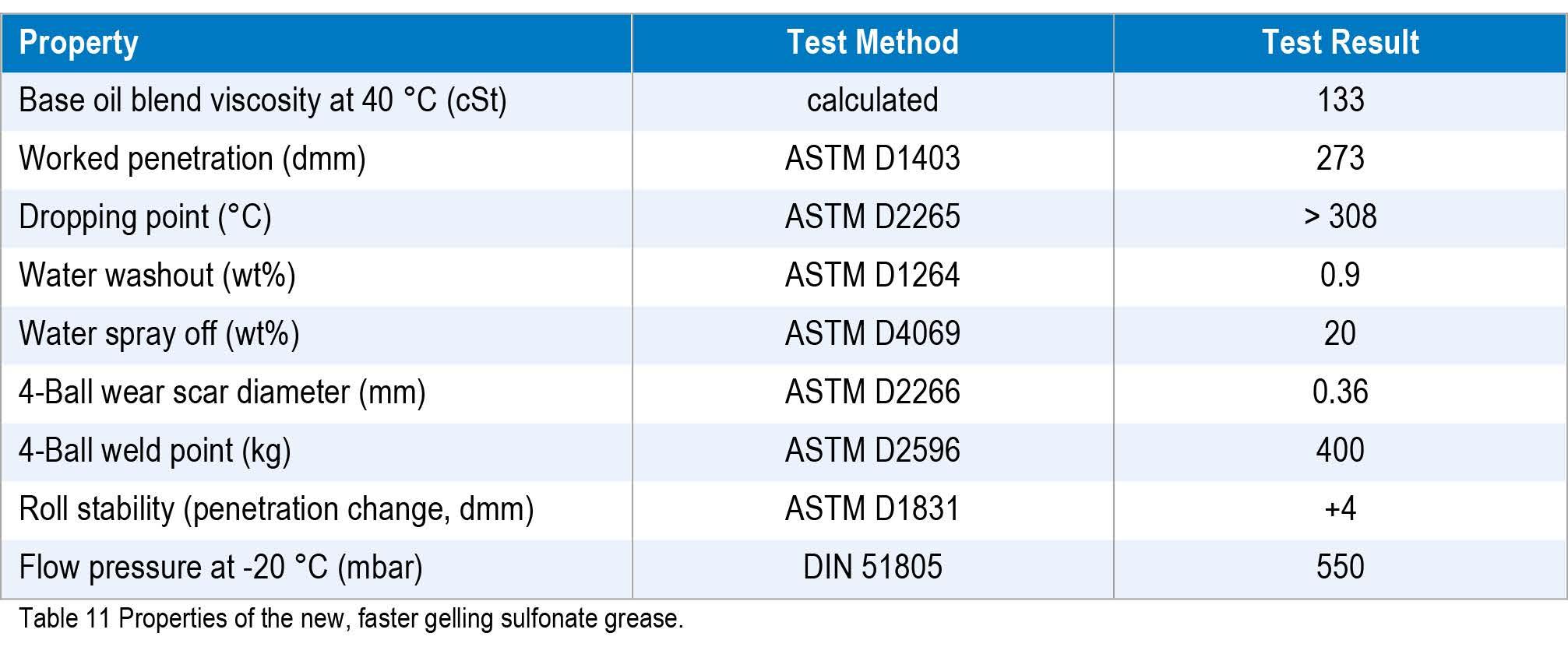
Calcium sulfonate complex greases
In 1985, Muir and Blokhuis (16) were granted US Patent 4,560,489 disclosing a calcium sulfonate complex grease that used boric acid and 12-hydroxystearic acid in the process. In the patent narrative, the sulfonate was described as being made from a natural sulfonate, and the water washout was reported as being similar to other greases. Subsequent work by Barnes (15) used synthetic rather than natural sulfonates and swapped out the boric acid for phosphoric acid. Both patents described a two-step process of gelation followed by saponification.
Olsen et al. (17) reported a further development of a one-step process to make calcium sulfonate complex greases by adding the acids with the lime.
Typical data for gelled calcium sulfonate, calcium sulfonate complex, and lithium complex thickener (without added polymer) greases with a similar oil blend are compared in Table 12. The sulfonate complex data in Table 12 were as reported by Barnes (15) and not independently verified.
Calcium sulfonate complexes have been historically sold as premium products offering good general properties and performance. The calcium sulfonate grease reported by Denis (14) is very much a premium product with excellent properties and has a much higher cost position compared to the two complex greases. The calcium sulfonate complex reported by Olsen et al (17) would be termed a high sulfonate - low soap complex. As the amount of soap in a grease is increased and the amount of sulfonate and calcite is reduced, the load carrying capacity of the grease decreases and the grease becomes less resistant to spray off. By moving to a low sulfonate - high soap grease, it should be possible to match the basic properties of lithium grease.
Acetic acid is used in many sulfonate grease making processes (15), (16) especially when the starting overbased calcium sulfonate has a high direct base number (DBN), which equates to the amount of “free” lime. One upside of using higher DBN sulfonates that require acetic acid for gelation is that they produce calcium acetate, which is well known to boost the Timken OK load. For some grease makers, it is not possible or desirable to use acetic acid, and so alternative acids are needed. If the grease has a lower amount of “free” lime, then it is typically easier to gel. As indicated earlier, there are issues in some markets with boric acids, and it is now preferable to avoid using them in sulfonate complex greases. Phosphoric acid, as per Barnes (15), can be used to make calcium phosphate in situ, or alternatively, calcium phosphate can be added as a powder or as calcium hydroxy apatite (18).
Synthetic linear alkylbenzene (LAB) sulfonates are typically the lowest cost position, and by using this as the sulfonate, along with a high level of calcium soaps, greases can be prepared to match the performance and cost of lithium complex greases. Calcium sulfonates used for grease are typically 400 TBN with DBN values of around 40 mg KOH / g eq. Additionally, 300 TBN calcium sulfonates, with DBN values from 30 mg KOH / g eq. to 40 mg KOH / g eq. can be used, but the process is more challenging.
In order to determine the cost and performance benefits of calcium sulfonate complexes and how they compare, three greases were manufactured with the same paraffinic brightstock (BS150) base oil, synthetic linear alkylbenzene sulfonate, dodecylbenzene sulfonic (DDBSA) and 12-hydroxystearic acids, glycol, lime and water. The formulations are listed in Table 13.

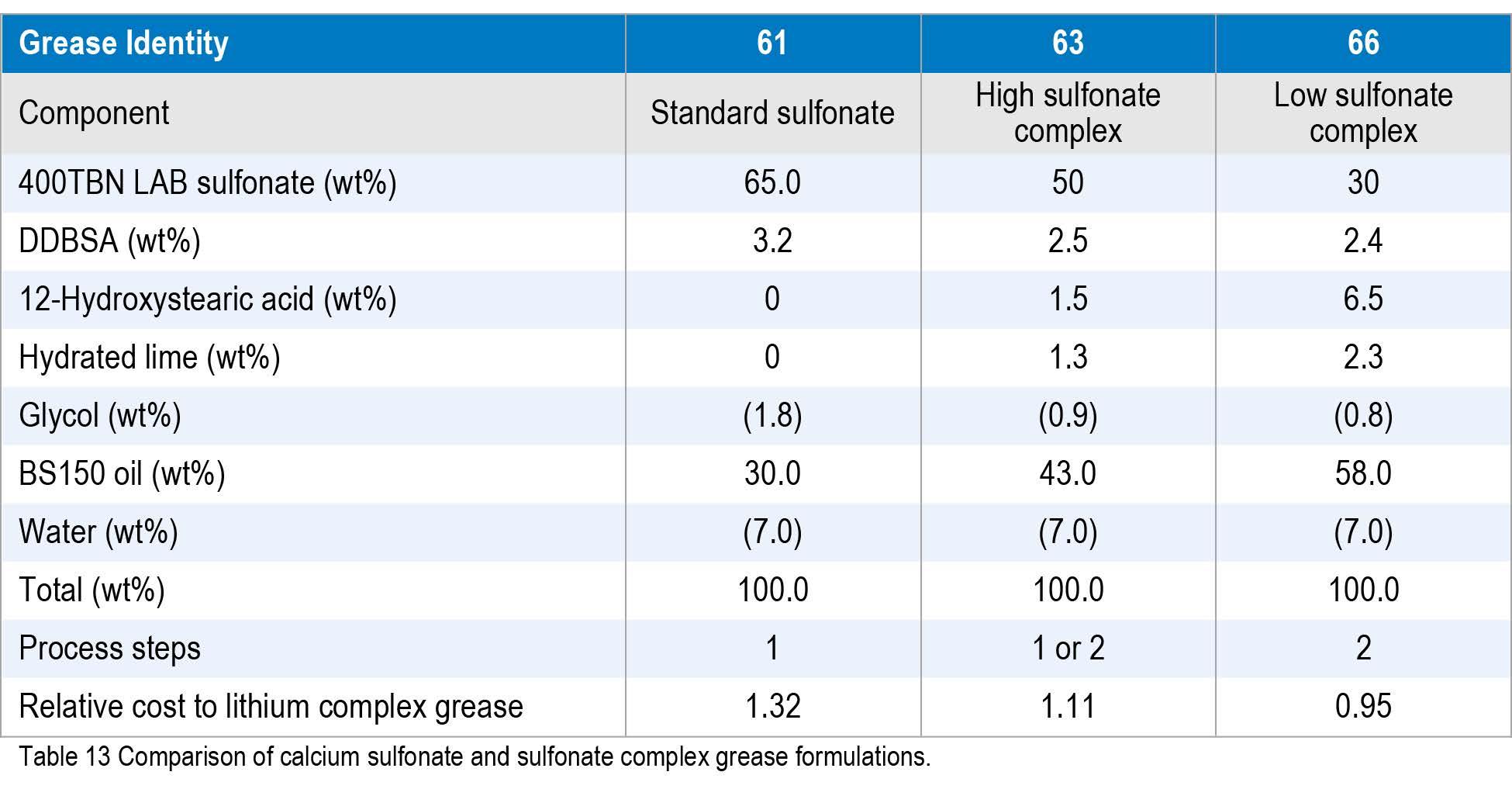
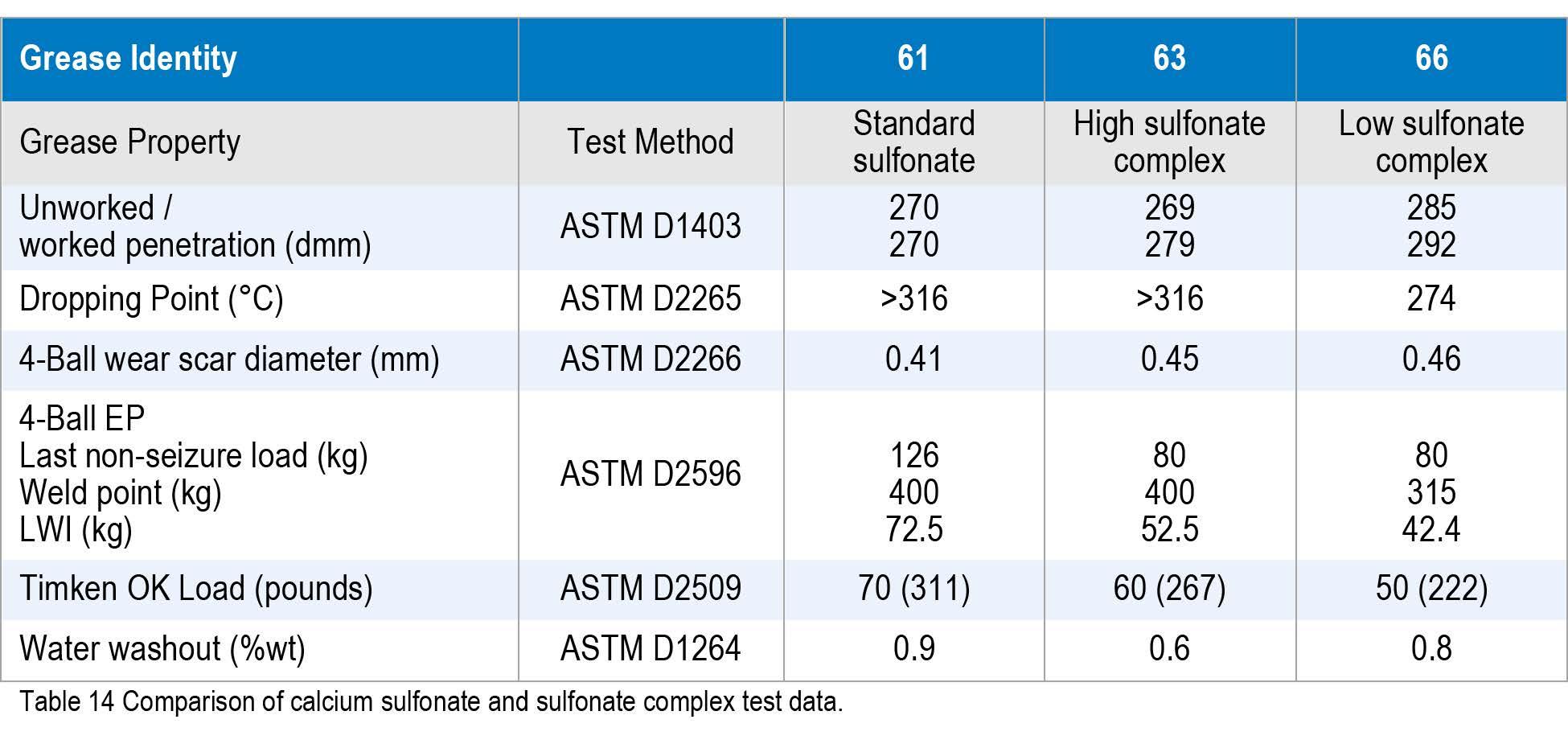
The three greases were then compared with standard property testing. As expected, the standard sulfonate performed better overall than the complexes, but at a higher raw material cost. These data show that the low sulfonate complex grease behaved similarly to an additized typical lithium complex grease.
Summary and Conclusions
This paper has shown that there are now several different routes available to help the grease producer to overcome the current cost and supply issues with lithium hydroxide monohydrate. The routes discussed were: manufacture greases with borate ester technology to reduce the amount of lithium; use anhydrous lithium hydroxide dispersions as alternative lithium sources; and offer high soap calcium sulfonate complexes. In this study, all three routes were used successfully to achieve performance comparable to standard lithium and lithium complex greases.
Acknowledgements
The authors wish to acknowledge many co-workers and departments within The Lubrizol Corporation for their contributions to this work.
References
(1) Grease Production Survey Report 2015, NLGI, Lee’s
Summit, Missouri 64063 (www.NLGI.org) (2) Grease Production Survey Report 2005, NLGI, Lee’s
Summit, Missouri 64063 (www.NLGI.org) (3) Ward, Jr., W. C., and Fish, G., “Development of Greases with Extended Grease and Bearing Life Using Pressure
Differential Scanning Calorimetry and Wheel Bearing
Life Testing.” NLGI Spokesman 2010 V74(5) pages 14-27
(4) Ward, Jr., W. C., and Qureshi, F.S. “Influence of components blended to a target base oil viscosity on liquid phase and lithium grease properties” NLGI Spokesman 2009 V74 (1) pages 21-31 (5) http://www.dakotaminerals.com.au/index.php/lithium/ about-lithium (6) Goyal, A.K., Parameshwaran, N., Ghosh, B., and Sengupta,
A. “Development of Advanced Calcium-Lithium Soap
Grease with Minimum Uses of Lithium Hydroxide”, 18th
NLGI India Annual Meeting, Aamby Valley City, Lonavala,
Maharashtra, February 2016 (7) Mazumdar, S. “Superior Performance of Titanium Complex
EP Grease in Steel Plant Applications – A Case Study” 18th
NLGI India Annual Meeting, Aamby Valley City, Lonavala,
Maharashtra, February 2016 (8) Deshmukh, V. “Polyurea Grease – An Ideal Cost Effective
Replacement for Lithium Complex Grease for Automotive and Industrial Applications” 19th NLGI India Annual
Meeting, Varanasi, Uttar Pradesh, February 2017 (9) NLGI Grease Guide, 6th Edition, 2015 NLGI, Lee’s Summit,
Missouri 64063 (www.NLGI.org) (10) Lorimor, J.J., “Improving the Heat Resistance of Simple
Lithium Soaps Using Borated Additives”, paper #0912, 77th
NLGI Annual Meeting, Bonita Springs, FL, June 2010 (11) Morgan, D., Kay, J.S. and Coe, C., “Critical Variables in
Lithium Complex Grease Manufacturing” paper #1313, 80th NLGI Annual General Meeting, Tucson, Arizona, 2013 (12) Fish, G. and Hsu, C., “Technology to Improve the Grease
Making Process” paper #1422, NLGI 81st Annual Meeting,
PGA National Resort, Palm Beach Gardens, Florida, June, 2014 (13) McMillen, R.L., “Basic Metal-Containing Thickened Oil
Compositions,” US Patent 3,242,079 USPTO March 22, 1966 (14) Denis, R.A and Sivik, M. R., “Calcium Sulfonate Grease-
Making Processes,” paper #0812, NLGI 75th Annual
Meeting, Williamsburg, Virginia, June, 2008 (15) Barnes, J. NCH Corporation, “Calcium Sulfonate Grease and Method of Manufacture”, U.S. Patent 5,126,062 USPTO
June 30, 1992. (16) Muir, R.J. and Blokhuis, W., “High Performance Calcium
Borate Modified Overbased Calcium Sulfonate Complex
Greases,” US patent 4,560,489 USPTO December 24, 1985 (17) Olsen, W.D., Muir, R.J., Eliades, T.I., and Steib, T., Witco
Corporation “Sulfonate Greases”, U.S. Patent 5,308,514
USPTO May 3, 1994. (18) Waynick, J.A., “Calcium Sulfonate Complex Greases Using
Calcium Hydroxyapatite as a Hydroxide-Containing Basic
Reactant” Paper #1508 NLGI 82nd Annual Meeting, Coeur d’Alene, Idaho, June, 2015
Soap Concentration Calculation
1) Determine the saponification number (Sap#) and molecular weight (Mw) for each acid. Sap# = 56110 x MolWt x n where 56110 is the number of milligrams in one gram-molecular weight of KOH and n is the number of KOH molecules that react with one acid molecule For 12-hydroxystearic acid (12HSA), Sap# is normally about 188, Mw is 300.483 g/mol, and n=1 For Azelaic acid (AA), Sap# is normally about 590. Mw = 188.22 g/mol, and n=2.
2) Then determine the number of equivalents (eq) Equivalents (moles) = grams/Mw Total up the number of acid equivalents Total acid eq = Eq12HSA + EqAA
3) Determine the % LiOH in the lithium source and the number of base equivalents
4) Subtract the acid eq from the base eq and from this determine the amount of free LiOH (grams)
5) Calculate the amount of each soap assuming 100% conversion Lithium 12-hydroxystearate (g) = Eq12HS*(Mw12HSA – 1.008
+6.94) where MwLi12HS = Mw12HSA – MwH + MwLi Dilithium azelate (g) = (EqAA/2)*(MwAA- 2.016+13.88) and MwLi2AA = MwAA – 2MwH + 2MwLi Free LiOH (grams) = Excess EqLi*23.94
6) Sum these three gram weights = amount of thickener (grams)
7) Add up the total amount of grease made % thickener = mass of thickener (g) / mass of grease (g)
Acid ratio calculator
Moles
Number of fatty acid moles: Number of complexing acid moles
Equivalents Number of fatty acid equivalents: Number of complexing acid equivalents
Worked example (5 kg of grease) 440 g 12-Hydroxystearic acid 1.474 moles = 1.474 equivalents 139 g Azelaic acid 0.737 moles = 1.474 equivalents 128 g LMH 3.056 moles = 3.056 equivalents 4400 g base oil Makes 600 g soap 2:1 molar acid ratio 12.0% thickener by weight






